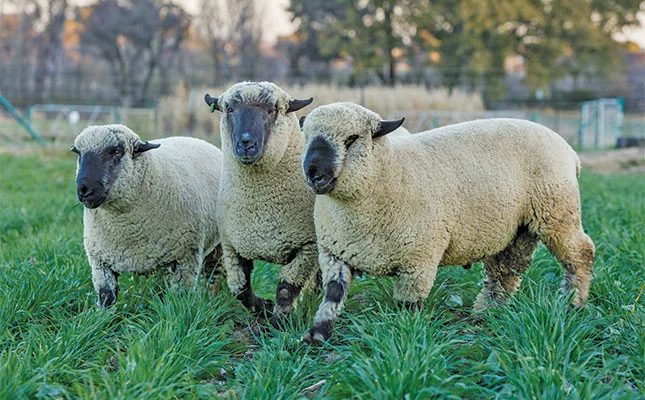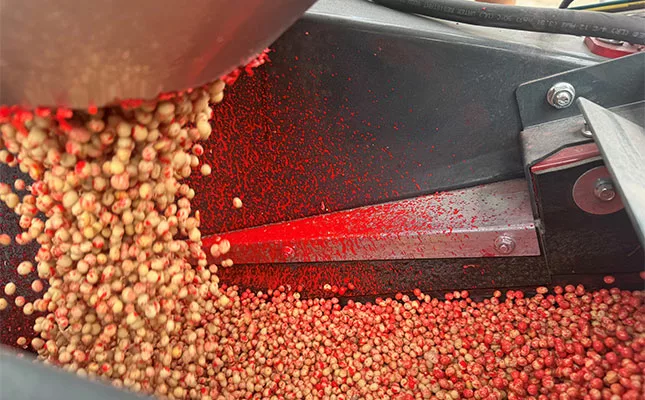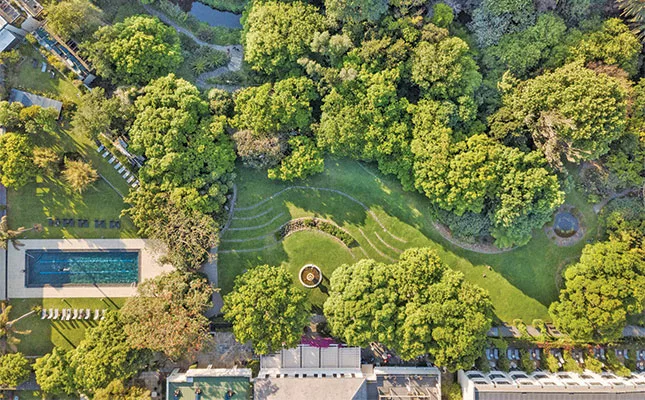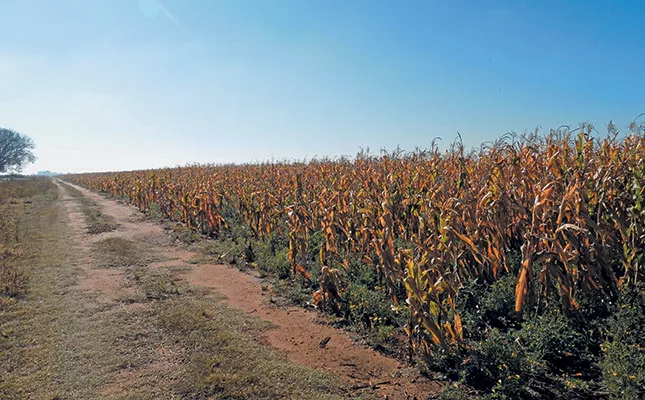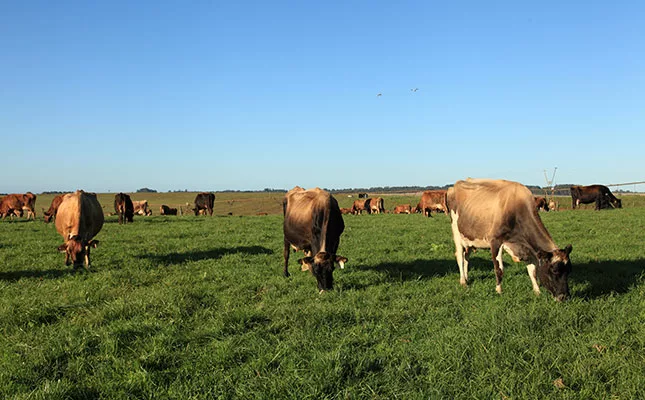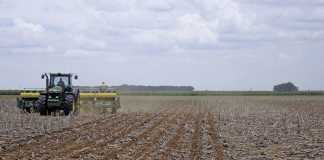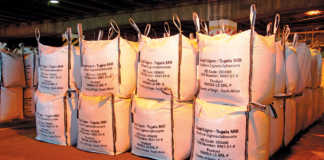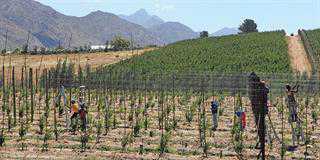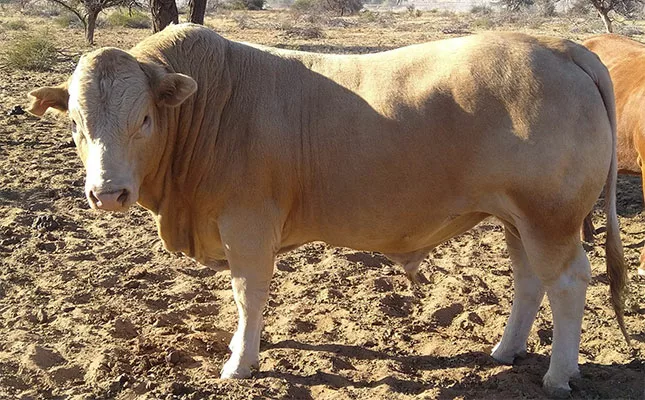
Photo: Supplied
The farm Elliesrust is located near Olifantshoek in the Kalahari and was purchased by Willie Storm from his father in 2003. Storm’s son Michiel joined him in 2019 and will be the fourth generation to work the family farm.
It is a dry, arid region, with average rainfall measurement of about 250mm. The Langeberg mountain range runs through it, creating terrain that is a 50/50 mix of plains and mountainous areas.
“We live in a semi-desert area. Rainfall is low and there are times when we get no rain at all. The Kalahari is a world of extremes,” says Storm.
In light of this, he has been implementing a regenerative agriculture approach at his farm for nearly two decades. In this time, he has grown his initial cow herd from 175 head to about 475 head. He was this year also named the fourth Veeplaas Climate-Smart Ambassador after having previously been a runner-up.
It has not been an easy journey, and has required significant financial investment and mental shifts across a variety of farming and management practices.
This has included his approach to veld management and bush clearing, stocking rates and grazing systems, and also suitability of the animals he is farming with.
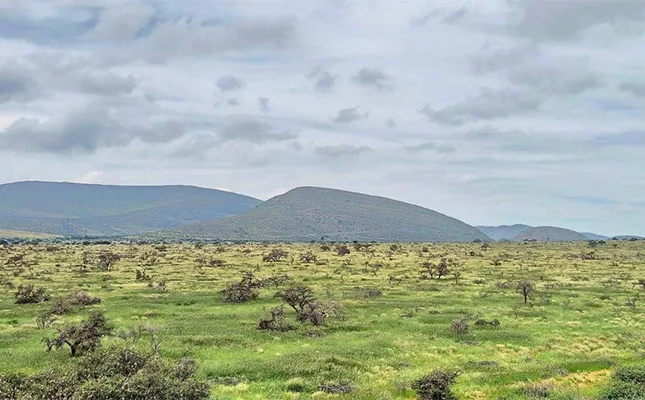
Drought resistance
When Storm began farming there in 1995, he leased 4 000ha of land from his father. Storm says his father and grandfather left a legacy of good infrastructure, including fences, handling facilities, watering points and large earth dams constructed as far back as the 1930s to capture rainfall run-off.
Unfortunately, the legacy did not extend to the grass, the soil and the biodiversity of the land.
“What I do is to measure the grazing on the land and that is something they never did,” he says.
Storm only truly embarked on his regenerative agriculture journey years after he’d taken over the farm. He was not merely buying into a concept; it was about looking for a way to overcome the risks posed by the seasonal ‘food drought’ experienced by farmers in his area every year around September/October, even in good rainfall years.
Storm says despite initially having tried to implement correct rotational grazing in accordance with the best textbook advice and guidance from agricultural technicians in the region, he too was experiencing the ‘feed drought’.
“Every year I would have this ‘drought’ on my farm, where there just wasn’t any grazing left and I would either have to reduce animals or buy in feed,” he says.
At that stage, he was still stocking at a carrying capacity in line with the norms for the region of around 21ha per large stock unit (LSU).
Part of the problem lay in the bush encroachment on large parts of the farm, as well as a lack of strong, established climax grass species (see box).
Storm says in the first decade of operations he believed he would be able to improve grazing conditions with rotational systems, but could never get ahead as the invasive bush just kept spreading.
“It was never-ending. And every year around September/October I would experience that feed drought.”
Making a mind shift
Storm says it took him 13 years to realise he had to do something differently.
“My first mind shift came with the decision to actively start bush clearing,” he says.
He embarked on a manual bush clearing programme from 2008, allocating funds in his farm management budget to the initiative.
He invested in the region of R1,8 million over the first nine years, budgeting about R200 000 per year. After the first three years when the dead wood had started maturing, he permitted a ‘young man’ to do the clearing and use the dead wood to sell as firewood.
“He paid me R2 per bundle. Over eight years that gave me R1,8 million back in my pocket, so the bush clearing actually paid for itself in the end,” says Storm.
He also budgeted for seed to re-establish good perennial climax grass species as opposed to annual pioneer variants.
“Pioneer grasses have good seed value. They grow quickly, but once grazed, die off without really putting anything back into the soil.”
This, in turn, also leaves gaps for invader bush to regain a foothold.
Climax grasses, on the other hand, put as much and more energy into the root system as into the leaves above ground, he explains. Once properly established, these grasses provide better nutrition, have longevity and also provide numerous soil health benefits.
Storm says the dead wood that remains on the land creates ‘safe sites’ for the establishment of grass species.
“The thorns and debris left behind make it difficult for animals to graze there. Seeds are sown in these safe sites and then have a chance to establish and grow strong without being grazed until the dead material has disintegrated over five to seven years.”
Select the right animals for scenario
When Storm purchased the farm from his father, he also bought his father’s cattle herd. He describes these cattle as a “Smartie box herd”, comprising a mix of breeds like Brahman, Hereford, Simmentaler and Charolais, among others.
He preferred the idea of red cattle and initially started introducing genetics into his cow herd with the use of Santa Getrudis bulls. However, the breed was not ideal for his environment.
“Today, I realise those cows were just too big to perform here,” he says.
In addition, they could not cope with the more mountainous parts of the farm.
As he continued on his journey to climate-smart farming, Storm realised he needed to look more closely at the type of animals he was running.
He began the process of ‘custom designing’ the right cattle breed for his environment with the introduction of Tuli bulls onto his cows. The Tuli brought numerous indigenous benefits in terms of hardiness and adaptability to harsh conditions, as well as a smaller frame.
He began by selecting for smaller cows, as well as applying strict culling practices on any cows that were not on par with the rest of the herd in terms of condition.
“Don’t be scared to select. If you see one cow in the group that is in poor condition [with no sign of injury or illness], next year she must be off the farm.”
Storm says he is hard on his animals and has high expectations. Cows in poor condition are not optimally productive and this affects criteria like inter-calving periods, for example.
Fertility for him is non-negotiable. Every cow needs to give him a calf every year.
He also selects and culls cows from his herd on an annual basis, slaughtering 10% to 15% of older or less suitable cows every time he increases his group numbers. This is important to ensure progress.
“Don’t be scared to cull those that are not improving your herd. You don’t want to mess up in one to three years what has taken many years to build,” says Storm.
He cautions against trying to change too rapidly. “It was a process to get there. As my veld improved, I increased my cow numbers over 10 to 15 years, relying on people with expertise,” he says.
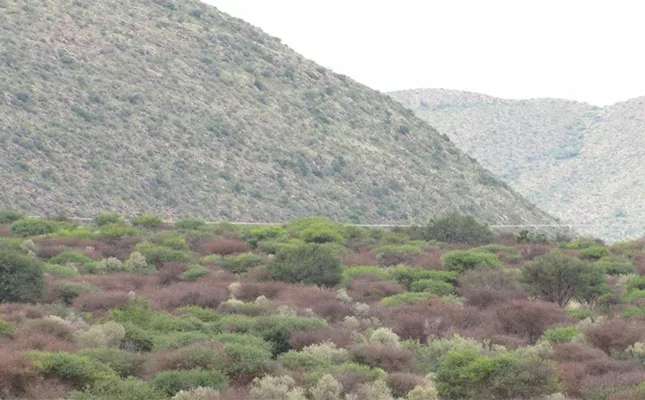
High-intensity grazing
In addition to the bush clearing and ‘designing’ his cows, Storm started measuring his grass (feed) and adapting the way in which he was grazing his camps.
Concepts such as high- or ultra-high-intensity grazing systems are not new and are utilised across a variety of operations, from irrigated pasture-based grazing systems to strip grazing in extensive environments.
When he first started his regenerative agriculture approach, Storm began by dividing his land into 28 big camps and rotating his five cow groups of about 35 cows per group more frequently.
He also began investing in additional land, bringing his total area up to about 5 000ha.
The principle was to graze a smaller area more harshly for a shorter period, allowing the cattle to trample the ground and work the manure in, and then allowing for a longer period of rest to facilitate regrowth and seeding every season.
Storm describes his approach as a high-intensity system. He avoided the ultra-high-intensity approach because he believes the Kalahari ecosystem is too sensitive and can be damaged beyond repair if over-utilised too harshly. This is in reference to the strip grazing approach, which he says can be very effective in other areas further to the east, for example.
In 2011, Storm invited Dr Louis du Pisani, a specialist agricultural consultant, to his farm to advise him on what he was doing.
He says Du Pisani was impressed with his progress, but told him he was stocking too conservatively and needed to make yet another mind shift.
“I was quite confident I was working in line with best principles, but he thought my camps were still too big.”
Storm took the plunge and reduced the size of his camps even further, creating roughly 75 camps across the entire 5 000ha area. The following year when Du Pisani visited again, he encouraged him to take it one step further and start increasing cow numbers.
Again, this went against what Storm thought were ‘sound principles’, but he respected Du Pisani’s expertise and started by adding 10 cows to each of his five groups that year, taking them up to 45 per group.
Today, Storm’s five groups each number between 90 and 120 cows. He has gone from a stocking rate of 21ha/LSU to 5ha/LSU and has more than doubled his cow volume.
Du Pisani still visits to consult every year, and in line with his guidance, camp sizes have decreased to about 66ha per camp on average, of which the smallest is about 5ha and the largest up to 250ha, depending on the location and terrain of the farm.
Storm says it has been years since he has experienced a September/October feed drought.
In 2015, he purchased a further 2 454ha, and at this stage this land is being farmed at 10ha/LSU.
In 2019, he acquired an additional 2 613ha, currently stocked at 20ha/LSU.
“The land was in a terrible state and I don’t want to harm the rehabilitation process, [which is why the density rate is being kept higher for the time being],” he says.
Multifaced approach
The work is ongoing and there is no one magic bullet. It requires constant management and adaptation. The bush clearing needs to be maintained to prevent regrowth, and the grass is managed carefully to ensure it is grazed optimally.
It is here that one cannot cheat, take short cuts, or defer the work. Veld management requires a hands-on, day-to-day interaction and familiarity with both the land and the animals. Storm visits his camps daily and measures and observes the cattle and the manner in which they are grazing to determine when they need to be rotated to the next camp.
“You will see it by the colour and texture of the manure, and the amount of lick they are consuming. A veld might look like it still has plenty of feed, but if the manure is brown and dry, you know they are not getting what they need off the veld,” he says.
Storm reflects on a visit to the Serengeti years ago and says he is trying to replicate this on a smaller scale with his camp design. He explains that each cow group is rotated among nine to 14 camps.
“[In the Serengeti], the animals start at point A and have a migratory route they follow before they end back at point A the next season. I am trying to simulate that.”
He says in nature, if there is more food along the migratory route, the animals will remain there longer, or move on more quickly if food becomes scarcer.
His observations of how his cattle are utilising the veld are intended to facilitate a similar process. The idea is that the animals only graze about two-thirds of the vegetation and then move on, allowing the remaining vegetation to regrow through the season and be able to seed itself. Cattle will likely only graze a camp for about six weeks in a one-year period, with the rest of the season dedicated to growth.
Storm is also not willing to lose the genetics he has been custom-breeding for his specific needs. In this case, he would make alternative arrangements to ensure he can retain his genetics by leasing land to graze cows so that his own veld still receives appropriate rest, for example.
It doesn’t happen by magic
Storm has been working at this for years and says it will never end. The more he is progressing, the more he is seeing changes and results, and the further he is shifting his own goalposts.
“I remember around 2015 there were just piles of dead wood all over. I said to my wife when that dead wood is gone, I can die happy.”
Now, the dead wood is gone in some places and has been replaced by rich, fertile grasslands. Bird and insect species have returned. He speaks about watching as dung beetles of all shapes and sizes race out as the manure hits the ground.
“Within half an hour, that manure patty has been carried away and taken back into the soil.”
He says he has been contacted by hundreds of other farmers over the years who have heard of his approach.
“They will come and look. They will say how amazing it is, how much grazing there is. But out of every 100 who visit, only about two will go back and implement it on their own farms. I find it astounding that the guys are not coming to the table.”
Storm says he used to feel disheartened by this, but now tries to remain positive, saying every individual who ‘converts’ is a bonus.
The results speak for themselves, but Storm cautions that it is a process that is both back-breaking and discouraging.
“Just when you think you’re making progress, there is a year where you have massive amounts of regrowth and it feels like you’re back to square one.”
It is at these times, he says, that you have to believe in what you are doing and see it through. This is often where the regenerative approach gets a negative reputation as people who have started the process and then give up too soon suffer compound losses.
On his own farm, he takes erosion patterns as an illustration of the long-term differences he is seeing. At least one of the large earth dams his grandfather constructed has not held water in years, with rainfall instead being absorbed into the ground by grass roots as opposed to eroding its flow into an artificial dam over barren, compacted ground.
“We had 300mm of rain in 2021 and none of that water collected in the dam; it all went into the soil.”
He says on a recent walk through a camp, he and his son counted 46 different
species of grass. These are not all climax grasses, but the diversity is something to be celebrated.
Storm is even seeing results in parasite control, with longer rest periods seeming to aid in breaking the cycle of the tick host.
“I vaccinate annually and dose with Ivomec Gold at the same time.
“In the past I used to have to do spot treatments a few times through the year, but in the last four years this has not been needed,” he says.
Vertical growth and future sustainability
Storm says there are many farmers who have not looked after their land in the past, instead purchasing new land to replace the over-utilised areas.
He says it is unsustainable to just keep farming until you have run your ground into the ground, eroding away at capacity year by year until it is no longer viable.
“Eventually the farm gets so far behind that production gets lower. My biggest worry is that the entire world is going that way.”
This is also a problem when it comes to encouraging younger generations to farm. The low productivity prospects and cost of land rehabilitation leave them unenthusiastic, resulting in farms gradually being taken over by mega-farmers.
Storm says it doesn’t have to be this way, though. His view is that a mind shift is needed to focus on vertical expansion on a farm, and optimising land so that it becomes more productive as well as healthy and resilient.
Current market challenges
Storm currently runs a weaner operation, marketing his animals directly to feedlots operated by Karan Beef. He is also an agent for Karan and says this year has been challenging due to the impact of the foot-and-mouth disease (FMD) outbreak.
At the time of speaking to Farmer’s Weekly, he said there had been no weaner purchases in his area for two months.
His own plans for the future are aimed at further minimising risk and hedging against this type of challenge.
Storm’s three-year plan is to start growing out his weaners on the farm, and eventually start his own feedlot there for finishing off before slaughter. He says he wishes he was able to fully implement this plan immediately, especially in light of the FMD impacts.
However, he still has three more years until he makes final payment on the farm and is therefore implementing this plan in stages.
This year, he intends keeping back one-third of the weaners he would usually market to background, moving to two-thirds the following year, and the entire weaner production by year three. This is not only about adding further value to the beef he is producing, but will also factor into his drought-resistance strategy.
“On 1 June every year I make a call based on the condition of my veld as to how much feed is available for the winter,” he says.
That is the end of the growing and rain season, so more or less rain at that point won’t really make a difference.
Storm says if he is backgrounding his own weaners on the farm and realises conditions are not good, he will then have the option of withdrawing those cattle to the feedlot, finishing them off and selling them for slaughter.
“This will automatically mean my lands are ‘understocked’ and I will then have place for my cows. The cow herd is my factory and I do not want to lose that.”
Although his region is challenging in terms of climate, Storm believes there are numerous pros that make it ideal for expansion along the entire value chain, including lower risks from pests and diseases.
“We are blessed; we farm in a healthy area here in the Northern Cape. It is hot and dry and we have low rainfall, so we have minimal parasites and diseases.
“We should turn this into a winning process and create export-accredited abattoirs here. Only the Northern Cape and Western Cape are free of FMD at the moment [as an example].”
Storm’s plans for the future are aimed at taking advantage of the full value chain.
For more information phone Willie Storm on 083 654 5460, or email him at [email protected].



